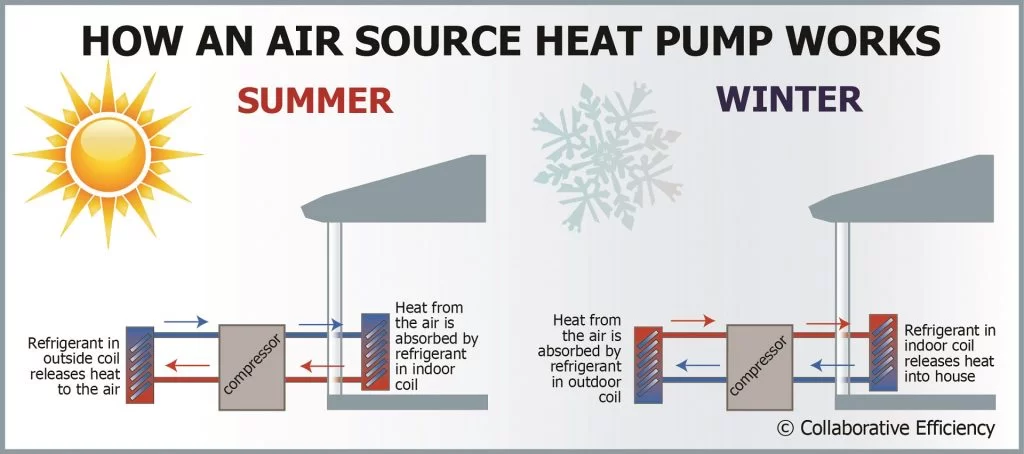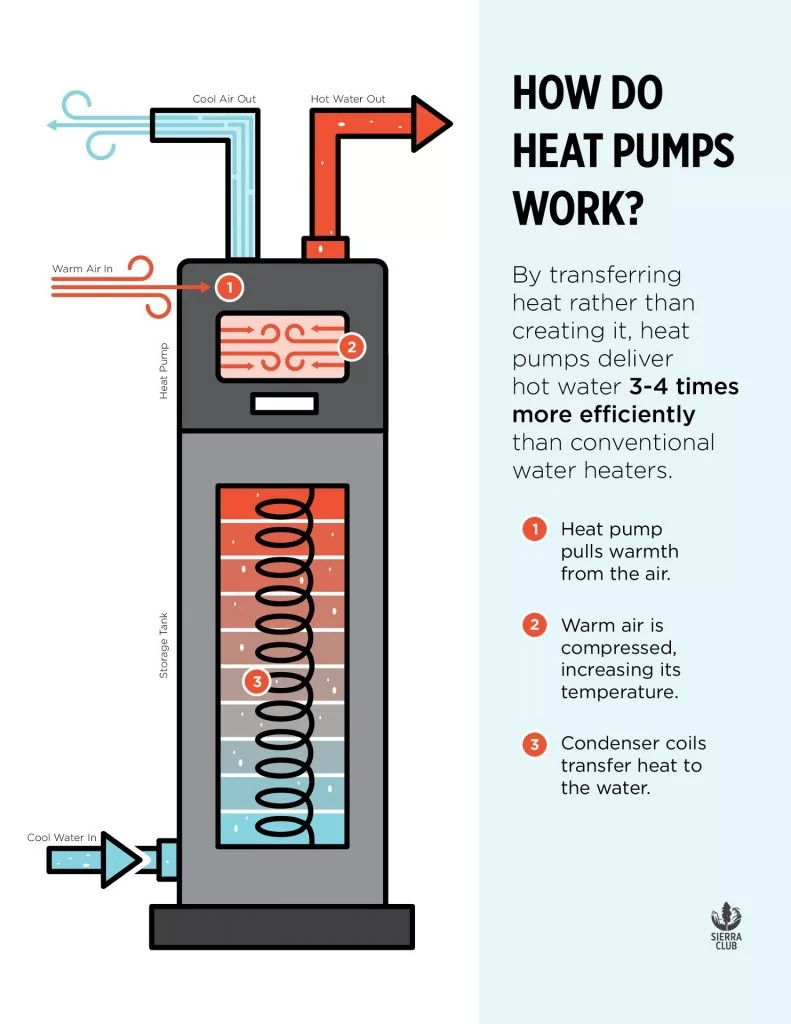Air To Water Heat Pumps FAQs
Heat pumps are a type of heating and cooling system that are popular for their versatility and efficiency. They’re different than standard air conditioning units, and the term ‘heat pump’ is sometimes used a catch-all for several types of HVAC systems. So, for this post we’ll aim to answer questions like:
Q. What is a heat pump?
A. heat pump is a well-established and highly efficient, electricity powered technology used for space heating and cooling, water heating, and drying clothes. Heat pumps use refrigerant and technology very similar to that of your common air conditioner, but, unlike air conditioners, heat pumps can also provide various kinds of heating for your home.
Q. What are the different types of heat pump appliances and equipment used in homes?
A. Heat pumps are used in homes most commonly for space heating and cooling and water heating. The most common heat pumps used for space heating and cooling (sometimes called “space conditioning”) exchange heat between indoor and outdoor air and are referred to as “air source” or “air-to-air” systems. Heat pump water heaters are referred to as “air-to-water” systems and are installed separately to heat water for showers and sinks just like traditional water heaters. Geothermal heat pumps used for space conditioning (see details below) are “water-to-air” or “water-to-water” systems. Finally, heat pump technology is also used in clothes dryer appliances.
Q. What are the advantages of heat pumps?
A. Unlike systems that burn gas to generate heat, heat pumps do not release greenhouse gasses into the atmosphere during operation. Heat pumps can run on electricity generated from rooftop solar systems or utility sources. Depending on the efficiency of your current system and whether you also do duct improvements and other sealing measures, your annual utility bill will likely be lower with a heat pump system. The most practical approach is to replace old systems that are ready to fail with generally more efficient heat pump systems. Project costs should be about $600 to $2,700 less to replace both an air conditioner and furnace with a heat pump, rather than with a new air conditioner and furnace. These costs were averaged over a range of efficiencies and sizes and were derived from estimating manuals and a survey of contractors.
Q. Are there incentives for heat pumps?
A. Yes! In Yolo County, the new TECH Clean California program allows participating contractors to earn between $3000 to $4800 in rebates for space conditioning heat pumps, depending on the fuels and efficiency of existing systems, plus additional rebates if duct sealing and detailed sizing calculations are performed. Also available are heat pump water heater rebates up to $3800, which can be installed by plumbers, and, for multi-family residential settings, there is an additional $2800 for needed electrical panel upgrades. Similar rebates are provided for multifamily apartments. Look for participating contractors on the TECH program website.
New TECH program incentives are designed to dovetail with the existing Comfortable Home Rebate program through PG&E whose website shows both rebates side by side.
Q. Why should I make a plan to replace my existing systems with heat pumps now?
A. If you wait for a breakdown, chances are you’ll need a new system fast, which doesn’t give you time to choose the heat pump that’s right for you. If your air conditioner is more than 15 years old, or especially if it is failing, getting three bids from participating contractors now will allow you to avoid stressful decisions in an urgent situation. Plus, incentives have never been better: the TECH program is scheduled to end December 2025 (the Comfortable Home Program, which makes up a much smaller portion of the incentives, is renewed annually).
Q. Are there other things I should consider?
A. Absolutely! Especially if you’re in an older home and the ducts are in the attic, you should strongly consider having the ceiling insulation removed, ceiling air leaks sealed, and replacing the ducts with new ones insulated to at least R-6. Ducts should be installed so they are resting on the floor of the attic, then new R-49 (or better) insulation can be blown on top of the ducts to provide additional insulation. Duct runs can also be shortened to decrease surface area and thermal losses. Finally, rather than installing the same size system as before, the new heat pump should be sized to take into account reduced heating and cooling load and reduced duct losses. These are the most important things you can do to reduce home energy use and yearly costs, and to improve comfort.
Q. I’ve been hearing a lot about “mini splits.” Are they heat pumps, too?
A. Yes. Most single-family homes have a “central” heating and cooling system that serves each room using ducts that deliver air through registers. Both traditional systems and heat pump systems can use ducts, but over the past decade “mini-split” or “ductless” heat pumps have also become common. Mini-splits have less heating and cooling capacity than central, ducted heat pump systems and usually only serve one or two rooms that are otherwise difficult to heat or cool with a central ducted system for a variety of reasons. Using wall or ceiling mounted “heads,” mini-split heat pumps tend to be more efficient. However, most homes would require more than one unit to cover multiple rooms, and the cost of treating an entire home this way could become cost prohibitive. Despite these differences, mini-splits work on the same principles as heat pumps and are eligible for similar rebates as well.
Q. What are “hybrid” or dual-fuel systems?
A. When temperatures approach freezing, “air source” heat pumps can be less efficient because they need to pause to defrost the outdoor coil (by reversing the cycle and going briefly into cooling mode to melt ice off the coil). One approach to addressing this limitation is hybrid or dual-fuel systems. Hybrid or dual-fuel systems include a natural gas furnace to cover times when heat pumps cannot provide sufficient heating quickly or efficiently (on colder days or when recovering from a nighttime or vacation setback). Hybrid systems can provide peace of mind for individuals hesitant to eliminate natural gas completely.
Q. What will it cost if I have to upgrade my electrical service?
A. Homes built before 1990 may require increasing electrical service capacity to accommodate added load from heat pump systems. If your existing electrical panel is rated at 200 amps or more, with rare exceptions, it should support a heat pump heating and cooling system, heat pump water heater, and electric vehicle charger. The cost to upgrade electrical service averages around $3,000. For older homes served by overhead wires or for newer homes with underground service with wires running through conduit, the cost is relatively low. Service upgrades are highest where wires are directly buried and new conduit and wires must be installed.
Q. Do I need electric resistance “heat strips” as part of my heat pump system?
A. Heat strips are a less efficient auxiliary heating feature sometimes installed by contractors to provide supplemental heating during very cold weather (and heat pump defrost cycles). Some contractors believe that heat strips are not needed in our climate if systems are designed properly with accurate load calculations and especially if ducts are in conditioned space or well-sealed and well-insulated in the attic. Mini-split heat pumps with variable speed compressors do not use heat strips. Heat strips also require a dedicated 240v circuit and which adds to costs.
Q. I’m building a new home, what kind of heating systems should I consider?
A. From the perspective of reducing greenhouse gas emissions, electricity powered space conditioning and water heating are the only choices. Going all-electric with heat pumps and induction cooktops is more expensive to install but — for new home construction — that cost is offset by eliminating the cost of installing gas piping. Also, ongoing gas service charges, whether gas is consumed or not, are eliminated. Since new homes are required to have rooftop solar systems in California, on-site electricity generation will likely reduce operating costs.
Q. How do heat pumps work?
A. Just as water runs downhill under the force of gravity, “hot” naturally flows to “cold” under thermodynamic forces. And as electricity can run a water pump to pump water uphill, it can also be used to move heat from cold to hot using the refrigeration cycle. For example, refrigerators and air conditioners extract heat from inside an insulated enclosure and “pump” it to the surrounding environment. Heat pumps can work both ways, that is they can move heat from indoors to outdoors (cooling) and from outdoors to indoors (heating).
To provide cooling, a compressor located inside the outdoor “condenser” unit compresses refrigerant gas, raising its temperature. The hot gas is cooled and condensed to a liquid by running it through a fan-cooled coil in the condenser. The cooled liquid is piped to another coil located at the indoor air handler where it passes through an expansion device, and as the refrigerant changes back to a gas, it absorbs heat from the coil. To provide heating the process is reversed, and refrigerant is condensed in the indoor coil where it gives off heat and the liquid expands in the outdoor coil where it draws heat from the outdoor air.
The reference is from Cool David, thanks!

 EN
EN
 AR
AR
 BG
BG
 HR
HR
 CS
CS
 DA
DA
 NL
NL
 FI
FI
 FR
FR
 DE
DE
 EL
EL
 HI
HI
 IT
IT
 JA
JA
 KO
KO
 NO
NO
 PL
PL
 PT
PT
 RO
RO
 RU
RU
 ES
ES
 SV
SV
 ID
ID
 LV
LV
 LT
LT
 SR
SR
 SK
SK
 SL
SL
 UK
UK
 VI
VI
 SQ
SQ
 ET
ET
 HU
HU
 TH
TH
 TR
TR
 MS
MS
 HY
HY
 HA
HA
 LO
LO
 MY
MY



